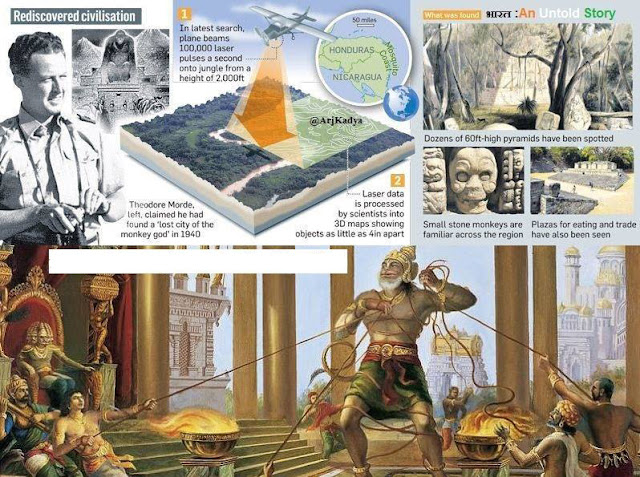Hanuman signs found Worldwide
La Ciudad Blanca [Spanish for ‘The White City‘) is a legendary settlement said to be located in the Mosquitia region of eastern Honduras (in Central America).Charles Lindberg, during one of his flights over the jungles of Mosquitia in Hondurus, claimed caught a glimpse of what he thought was the ‘Lost City of the Monkey God‘ where, legend says that local people worshipped huge ‘Monkey Sculptures‘.Theodore Morde – an American adventurer, worked on the tip given by Lindberg and claimed that he had finally found the lost city in 1940.He claimed sacrifices were made by local Indians to a gigantic idol of an ape. However, he was killed by a car in London before he could announce its exact location.
Ramayana’s Kishkinda Kanda descibes about Trident of Peru, South America etc and Yuddha Kanda(War Episode) describes about Hanuman travelling to Paatala Loka (Central America and Brazil, which are on other side of India in globe) and meeting his son Makaradhwaja, who resembles him.After killing the King of Paatala, Hanuman makes his son Makaradhwaja as ruler of that kingdom and he is being worshipped as God since then.This could be one of the reasons why ancient americans of central and south paint red color to all their gods statues.The discovery of Vedic Havan Kund in peru is also one more evidence of Vedic influence in this region.
Morde speculated that the deity statue of a “Monkey God" was an American parallel to the Hindu deity Hanuman, who he says was the equivalent of America’s own Paul Bunyan in his amazing feats of strength and daring.Morde was told that the temple had a “long, staired approach” lined with stone effigies of monkeys. “The heart of the Temple was a high stone dais on which was the statue of the Monkey God himself. Before it was a place of sacrifice.Morde and Brown brought back thousands of artifacts, most of which became part of the collection of the Heye Foundation Museum of the American Indian in New York City.These included metal razors, stone blades, a flute, stone statuary, and stone utensils. Morde and Brown also reported having found evidence of gold, silver, platinum, and oil and are now at display in National Museum of the American Indian in Washington, D.C.Later, journalists and authors have associated Morde’s “City of the Monkey God” with La Ciudad Blanca.
Ramayana’s Kishkinda Kanda descibes about Trident of Peru, South America etc and Yuddha Kanda(War Episode) describes about Hanuman travelling to Paatala Loka (Central America and Brazil, which are on other side of India in globe) and meeting his son Makaradhwaja, who resembles him.After killing the King of Paatala, Hanuman makes his son Makaradhwaja as ruler of that kingdom and he is being worshipped as God since then.This could be one of the reasons why ancient americans of central and south paint red color to all their gods statues.The discovery of Vedic Havan Kund in peru is also one more evidence of Vedic influence in this region.
Morde speculated that the deity statue of a “Monkey God" was an American parallel to the Hindu deity Hanuman, who he says was the equivalent of America’s own Paul Bunyan in his amazing feats of strength and daring.Morde was told that the temple had a “long, staired approach” lined with stone effigies of monkeys. “The heart of the Temple was a high stone dais on which was the statue of the Monkey God himself. Before it was a place of sacrifice.Morde and Brown brought back thousands of artifacts, most of which became part of the collection of the Heye Foundation Museum of the American Indian in New York City.These included metal razors, stone blades, a flute, stone statuary, and stone utensils. Morde and Brown also reported having found evidence of gold, silver, platinum, and oil and are now at display in National Museum of the American Indian in Washington, D.C.Later, journalists and authors have associated Morde’s “City of the Monkey God” with La Ciudad Blanca.


